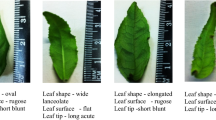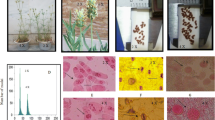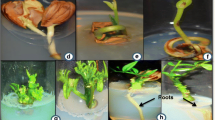Abstract
Hypericum perforatum L. (St. John’s wort) is an important medicinal herb and a subject of intensive research for its complex and diverse bioactive chemicals. An in vitro-grown germplasm collection of elite H. perforatum lines, established to provide easy access to physiologically uniform plants, was used for ploidy assessment studies. Germplasm lines were maintained by repeated subculture of shoot tips for over 10 yr with little change in their capacity to produce multiple shoots. Shoots of four of these lines were rooted and grown in the greenhouse to obtain plants to provide anther and filament explants. Culture of explants on a regeneration medium supplemented with 1 mg L−1 α-naphthaleneacetic acid (NAA) and 1 mg L−1 6-benzylaminopurine (BA) induced large numbers of calluses and shoots on all explants. Flow cytometric (FCM) analysis of nuclei samples revealed that the nuclear DNA contents of calluses and shoots developed from anther and filament explants of germplasm lines were not significantly different from those of the donor plants. FCM screening of in vitro-maintained germplasm lines in the collection showed that they had similar nuclear DNA amounts and were all tetraploid (2n = 4x). Analysis of seedlings obtained from the original seed source used to derive the germplasm lines showed that ~11% of them were hexaploid (2n = 6x). Data obtained from FCM screens confirmed the preservation of tetraploidy in in vitro-maintained H. perforatum germplasm and the regenerants obtained from male floral organs. The consistent ploidy of the H. perforatum plants of in vitro origin further supports the usefulness of such technologies to ensure genetic uniformity of medicinal plants over extended periods of culture and may facilitate long-term preservation of their elite clones.



Similar content being viewed by others
References
Agostinis P, Vantieghem A, Merlevede W, Peter AM (2002) Hypericin in cancer treatment: more light on the way. Int J Biochem Cell Biol 34:221–241
Alan AR, Zeng H, Assani A, Shi WI, McRae HE, Murch SJ, Saxena PK (2007) Assessment of genetic stability of the germplasm lines of medicinal plant Scutellaria baicalensis Georgi (Huang-qin) in long-term, in vitro maintained cultures. Plant Cell Rep 26:1345–1355
Arumuganathan K, Earle ED (1991) Nuclear DNA content of some important plant species by flow cytometry. Plant Mol Biol Report 9:208–218
Barnes J, Anderson LA, Phillipson JD (2001) St John’s wort (Hypericum perforatum L.): a review of its chemistry, pharmacology and clinical properties. J Pharm Pharmacol 53:583–600
Bennett MD, Leitch IJ, Price HJ, Johnston JS (2003) Comparisons with Caenorhabditis (~100 Mb) and Drosophila (~175 Mb) using flow cytometry show genome size in Arabidopsis to be ~157 Mb and ~25% larger than the Arabidopsis genome initiative estimate of ~125 Mb. Ann Bot 91:547–557
Bergonzi MC, Bilia AR, Gallori S, Guerrini D, Vincieri FF (2001) Variability in the content of the constituents of Hypericum perforatum L. and some commercial extracts. Drug Dev Ind Pharm 27:491–497
Brutovská R, Čellárová E, Doležel J (1998) Cytogenetic variability of in vitro regenerated Hypericum perforatum L. plants and their seed progenies. Plant Sci 133:221–229
Butterweck V (2003) Mechanism of action of St John’s wort in depression: what is known? CNS Drugs 17:539–562
Campbell MH, Delfosse ES (1984) The biology of Australian weeds. 13. Hypericum perforatum. J Aust Agric Sci 50:63–73
Čellárová E, Daxnerová Z, Kimáková K, Halušková J (1994) The variability of the hypericin content in the regenerants of Hypericum perforatum. Acta Biotechnol 14:267–274
Crompton CW, Hall IV, Jensen KIN, Hildebrand PD (1988) The biology of Canadian weeds. 83. Hypericum perforatum L. Can J Plant Sci 68:149–162
Doležel J, Bartoš J (2005) Plant DNA flow cytometry and estimation of genome size. Ann Bot 95:99–110
Doležel J, Bartoš J, Voglmayr H, Greilhuber J (2003) Nuclear DNA content and genome size of trout and human. Cytometry A 51A:127–128
Gamborg OL, Miller RA, Ojima K (1968) Nutrient requirements of suspension cultures of soybean root cells. Exp Cell Res 50:151–158
Kasper S, Caraci F, Forti B, Drago F, Aguglia E (2010) Efficacy and tolerability of Hypericum extract for the treatment of mild to moderate depression. Eur Neuropsychopharmacol 20:747–765
Matzk F, Meister A, Schubert I (2000) An efficient screen for reproductive pathways using mature seeds of monocots and dicots. Plant J 21:97–108
Murashige T, Skoog F (1962) A revised medium for rapid growth and bioassays with tobacco tissue cultures. Physiol Plant 15:473–497
Murch SJ, Saxena PK (2006a) A melatonin-rich germplasm line of St. John’s wort (Hypericum perforatum L.). J Pineal Res 41:284–287
Murch SJ, Saxena PK (2006b) St. John’s wort (Hypericum perforatum L.): challenges and strategies for production of chemically consistent plants. Can J Plant Sci 86:765–771
Murch SJ, KrishnaRaj S, Saxena PK (2000) Tryptophan is a precursor for melatonin and serotonin biosynthesis in in vitro regenerated St. John’s wort (Hypericum perforatum L. cv. Anthos) plants. Plant Cell Rep 19:698–704
Murch SJ, Ragone D, Shi WL, Alan AR, Saxena PK (2008) In vitro conservation and sustained production of breadfruit (Artocarpus altilis, Moraceae): modern technologies for a traditional tropical crop. Naturwissenschaften 95:99–107
Patocka J (2003) The chemistry, pharmacology, and toxicology of the biologically active constituents of the herb Hypericum perforatum L. J Appl Biomed 1:61–73
Perez-Garcia F, Huertas M, Mora E, Pena B, Varela F, Gonzalez-Benito ME (2006) Hypericum perforatum L. seed germination: interpopulation variation and effect of light, temperature, presowing treatments and seed desiccation. Genet Resour Crop Evol 53:1187–1198
Petijová L, Skyba M, Čellárová E (2012) Genotype-dependent response of St. John’s wort (Hypericum perforatum L.) shoot tips to cryogenic treatment: effect of pre-culture conditions on post-thaw recovery. Plant OMICS 5:291–297
Phillips RL, Kaeppler SM, Olhoft P (1994) Genetic instability of plant tissue cultures: breakdown of normal controls. Proc Natl Acad Sci U S A 91:5222–5226
Robson NKB, Adams P (1968) Chromosome numbers in Hypericum and related genera. Brittonia 20:95–106
SAS Institute (2004) SAS/STAT 9.1 User’s Guide. SAS Institute Inc., Cary
Schinazi RF, Chu CK, Babu JR, Oswald B, Saalman V, Cannon DL, Ericksson BFH, Nasr M (1990) Anthraquinones as a new class of antiviral agents against human immunodeficiency virus. Antivir Res 13:265–272
Silva BA, Dias ACP, Ferreres F, Malva JO, Oliveira CR (2004) Neuroprotective effect of H. perforatum extracts on beta-amyloid-induced neurotoxicity. Neurotox Res 6:1–12
Silva BA, Ferreres F, Malva JO, Dias ACP (2005) Phytochemical and antioxidant characterization of Hypericum perforatum alcoholic extracts. Food Chem 90:157–167
Skyba M, Urbanová M, Kapchina-Toteva V, Košuth J, Harding K, Čellárová E (2010) Physiological, biochemical and molecular characteristics of cryopreserved Hypericum perforatum L. shoot tips. CryoLetters 31:249–260
Uchendu EE, Shukla MR, Reed BM, Saxena PK (2014) Efficient method for cryopreservation of St John’s wort and tobacco: role of melatonin. Acta Hortic 1039:233–241
Urbanová M, Čellárová E, Kimáková K (2002) Chromosome number stability and mitotic activity of cryopreserved Hypericum perforatum L. meristems. Plant Cell Rep 20:1082–1086
Urbanová M, Košuth J, Čellárová E (2006) Genetic and biochemical analysis of Hypericum perforatum L. plants regenerated after cryopreservation. Plant Cell Rep 25:140–147
Acknowledgments
This research was supported by grants from the Natural Sciences and Engineering Research Council of Canada and the Gosling Foundation, Guelph, Ontario, Canada.
Author information
Authors and Affiliations
Corresponding author
Additional information
Editor: David Duncan
Rights and permissions
About this article
Cite this article
Alan, A.R., Murch, S.J. & Saxena, P.K. Evaluation of ploidy variations in Hypericum perforatum L. (St. John’s wort) germplasm from seeds, in vitro germplasm collection, and regenerants from floral cultures. In Vitro Cell.Dev.Biol.-Plant 51, 452–462 (2015). https://doi.org/10.1007/s11627-015-9708-7
Received:
Accepted:
Published:
Issue Date:
DOI: https://doi.org/10.1007/s11627-015-9708-7




